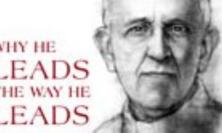The way in which business leaders think and operate has changed a great deal in recent decades, writes Quentin de la Bédoyère, particularly when it comes to management structures in their organisations. Are there any parallels to be drawn between corporate practice and the way in which leadership functions in the Church?
‘...many claim the right to organize the Church as if she were a multinational corporation and thus subject to a purely human form of authority. In reality, the Church as mystery is not “our” but “his” Church: the People of God, the Body of Christ and the Temple of the Holy Spirit.’ So wrote John Paul II to the German Bishops, referring to what the Extraordinary Synod of 1985 noted as a tendency of certain lay organisations to ‘critically consider the Church a mere institution.’[1]
Of course the Church is not a ‘mere institution’ but it does have a lot in common with the multinational corporations referred to by Pope John Paul II: it is a society of human beings and therefore it exhibits human characteristics. As such, it needs to take note of the best understanding of how organisations can be ordered for maximum effectiveness – an understanding which became apparent in the middle of the 20th century. While many secular organisations responded to these changes of culture, many feel that the Church has failed to do so.[2] An appreciation of the developments in management theory and practice in recent decades might provide the Church with the tools it needs to respond to such changes and therefore to the needs of its members.
The new management
The changes in management thinking that have occurred are in essence based on a new understanding of the human relationship to work. The move has been from regarding workers as tools in the process, guided by a system of rewards and punishments, to regarding them as responsible, motivated and active participants in the goals of an organisation.[3] This followed work on the nature of motivation, which showed that once the ‘basic needs’ were satisfied, motivation came from ‘higher needs’ such as love, autonomy and self-fulfilment.[4] The worker was no longer a robot with a brain, but a human being meeting his personal aspirations through his work.
This shift in understanding of the motivation of the workforce called for a corresponding change in the nature of leadership. This form of leadership requires a clear view of the future of a business, an accurate picture of its strengths and weakness, and a firm grasp of the (often relatively few) essentials which have to be got right. The vision of what the business is really about and where it is going is set from the top but must be credible to the whole community and must infuse its members at every level. Influence has replaced power as the major tool of the leader and has, in practice, much greater effect on the welfare of the business. However, the formal power and hierarchy remains intact, and is used where necessary, but only where necessary, to regulate and secure the business; this is called the ‘tight-loose principle’. (Parents will be familiar with this through the judicious balance which enables them to keep their children safe while maximising their opportunities to learn the value of autonomy.) The same general approach is repeated in microcosm at each level of the organisation. However great the active participation of all levels in the objectives of the business, it is leadership from the top which gives direction, inspiration and coordination.
There are two things to notice about this. The first is that this thinking is entirely consistent with the Church’s teaching authority. The chief executive of a secular organisation must lay down the necessary standards and values; so must the Magisterium. But if these imperatives are proposed and supported primarily as the means through which success may be achieved, rather than as a source of sanctions, then they will have the capacity to inspire. The second point is that the more fully the authority respects the autonomy of its members and the more it provides opportunities for self-fulfilment, the more influence it is likely to have.
Management in the Church
Are these concepts antipathetic to the Church’s understanding of society and the Church’s understanding of herself? It would seem not. According to the Catholic Compendium of Social Doctrine:
Just as it is gravely wrong to take from individuals what they can accomplish by their own initiative and industry and give it to the community, so also it is an injustice and at the same time a grave evil and disturbance of right order to assign to a greater and higher association what lesser and subordinate organizations can do. For every social activity ought of its very nature to furnish help to the members of the body social, and never destroy and absorb them.[5]
This indicates that a leadership policy in the secular organisation which enables workers to fulfil themselves through an appropriate level of responsibility is not merely empirically efficient but is to be seen as an imperative deduced from human nature. Must it therefore apply to the organisation of the Church?
Perhaps not. At the 2001 Synod of Bishops, Cardinal Bergoglio, who held official position, declared that, ‘The singular hierarchical structure of the Church, existing by the will of Christ, excludes an application of the principle of subsidiarity to the Church in the way in which it is intended and applied in sociology.’[6] Nor has it applied in practice. Cardinal König wrote in 1999: ‘In fact however, de facto and not de jure, intentionally or unintentionally, the curial authorities working in conjunction with the Pope have appropriated the tasks of the episcopal college. It is they who carry out almost all of them.’[7]
We might contrast that with Pius XII’s view:
‘..all social activity by its nature is subsidiary; it should serve as a support for the members of the social body and never destroy them or absorb them.’ These words are indeed illuminating. They apply to all levels of life in society as well as to the life of the Church, without prejudice to her hierarchical structure.[8]
The contradiction between the words of Cardinals Bergoglio and König, and those of Pope Pius XII, is not as stark as it may at first appear. By the 1990s, the word ‘subsidiarity’ had become a proxy for revolutionary decentralisation. And it is important to note the qualification: ‘without prejudice to her hierarchical structure.’
What does this qualification mean? It is a matter of experience that authorities of different kinds have a tendency to accept subsidiarity wholeheartedly in theory but then to discover that it does not in fact apply to their own situation. So, for example, a financial executive might say, and believe, that the rigorous regulation to which their business is subject precludes subsidiarity. But in fact subsidiarity does not preclude regulation in essential matters. Thus the financial company may well require, for instance, that an accurate record of transactions should be maintained, or that expense accounts must be audited on a sample basis. Once more, an analogy might be the wise parent who imposes as few rules as possible but requires that those minimal rules should be observed.
So, ‘without prejudice to her hierarchical structure’ might, for example, refer to the ultimate authority to teach doctrine and morals. And here the conditions surrounding the exercise of infallibility demonstrate the boundaries of this authority. Thus Cardinal Newman distinguishes between the potential infallibility of teaching and the high, but not absolute, authority of papal commands.[9]
The challenges of a change in culture
There are of course issues which make the development of true subsidiarity difficult. The first is that, when an organisation has an extreme top-down culture, the core of its members will be accustomed to a secure situation in which obedience to the rules makes for comfort and safety. Psychological accounting then leads them into valuing the disciplines of the culture positively. So when the culture changes there may be unfortunate reactions.
For many there is discomfort and uncertainty: the values of the former regime that they have upheld so loyally have become a liability and, in this scenario, they may be asked to exercise the hitherto unused skill of autonomy. The response may be to fight against the new values – perhaps by taking up more extreme positions.
Others will have resented the old values. They may have argued against the regime and even indulged in minor disobediences. They are now faced with a freedom that they have often demanded but may not know how to handle. A period of disorder is likely to ensue in which radical extremes may be explored. It may take quite a long period before these enthusiasts learn the discernment and the tactful self-control which will enable them to contribute constructively to developing the new culture.
Of course the danger here is that those in authority, witnessing their hitherto loyal members in resentful distress – as well as the radicals breaking loose – may panic and pull the plug.
Another serious problem finds its source in the likelihood that the members of the organisation are suited by temperament to its existing culture. We seek employment in an organisation which promises to meet our (often unconscious) psychological needs. And we are more likely to stay if that promise is met. Moreover, many of the management group at various levels will have succeeded by meeting the values of the organisation. These people are being asked to continue their membership in an unfamiliar and less sympathetic culture. They will at best bear silent resentment and at worst be actively opposed. It may take ten years or more for the personnel changes to flush through the system. In the meantime the organisation may operate in some respects at a lower level than under the former culture. It requires courage and pertinacity to see the changes through.[10]
Insofar as the Church shares the characteristics of a secular organisation, the introduction of subsidiarity into the Church as a whole is likely to prove extremely difficult. It will take vision and determination from the top. And it will require a firm faith that treating the priesthood of all its members with the dignity that this necessitates will produce the best results – even if it will often seem not to be so.
Subsidiarity and communication
It is not my purpose here to explore how the adoption of subsidiarity by the Church would, or should, take place in practice. But I am tempted to suggest at least a starting point.
Several years ago I was conducting a project to identify the characteristics of successful life assurance companies. On one occasion I had to wait for a few minutes in the foyer. I asked the commissionaire about the company and he gave me a good description of its aims and values. Ten minutes later I was on the 12th floor asking the same question of the chief executive and I received exactly the same answer. I was to conclude that if one wanted to identify a potentially successful organisation by a single characteristic, that characteristic would be communication.
In July 1964, Donald Nicholl[11] wrote an article in the Clergy Review titled ‘The Layman and Ecclesiastical Authority’. In this he recalled a study[12] reported by Professor Revans[13] who investigated why certain hospitals were less successful in retaining staff than others. It appears that the ‘good’ hospitals retained their staff at all levels by comparison. Indeed the only people who stayed longer at the ‘poor’ hospitals were the patients, who failed to get better as quickly. Revans concluded that the prime difference lay in communication. In the ‘poor’ hospitals communication only went one way – downwards. There was friction between staff at various levels, and the patients appeared to be regarded as an unavoidable evil. In the ‘good’ hospitals there was communication upwards, downwards and from side to side. As Revans said: ‘When doctors listen to nurses, patients recover more quickly.’
While I am reminded that this study might still be pertinent to hospitals today, Nicholl of course asks whether ecclesiastical authority could also learn from it. On being questioned, Revans said that a fundamental change in the nature of this communication is likely only to come from decisive action at the top. But that was nearly 40 years ago – the mills of God grind slowly.
Good communication creates good community. Good community is characterised by trust and the sharing of a common task. With trust comes the sharing of vision which enables all the organs of the Mystical Body to contribute to the whole. Do I dare to hope that we might just find the sort of strong, perhaps charismatic, leadership to instigate this communication in Pope Francis?
Quentin de la Bédoyère is Science Editor for the Catholic Herald and author of Autonomy and Obedience in the Catholic Church (T&T Clark, 2002).
[1] Address of Pope John Paul II to the German bishops, 20 November 1999: http://www.vatican.va/holy_father/john_paul_ii/speeches/1999/documents/hf_jp-ii_spe_20111999_ad-limina-german_en.html
[2] Mary McAleese, Quo Vadis?: Collegiality in the Code of Canon Law (Columba Press, 2012), chapter 4, passim.
[3] The classic account of the contrasting approaches, known as X theory and Y Theory are described by Douglas McGregor in The Human Side of Enterprise (McGraw-Hill, 1960).
[4] The best known analysis of the hierarchy of human motivation is ‛A theory of human motivation' by Abraham Maslow, Psychological Review, 50 (1943).
[5] Catholic Compendium of Social Doctrine, §186. See for context: :http://www.vatican.va/roman_curia/pontifical_councils/justpeace/documents/rc_pc_justpeace_doc_20060526_compendio-dott-soc_en.html.
[6] The Tablet (20 October 2001). Cardinal Bergoglio, who took over his brief as Relator from another cardinal, was not necessarily giving his own opinion.
[7] The Tablet. 27 March 1999.
[8] Address to new cardinals,1946. Pius XII is quoting from, and commenting on, Quadragesimo Anno
[9] John Henry Newman, Letter to the Duke of Norfolk (1875).
[10] The factors involved in changing the culture of a commercial company are discussed at length in chapter 5 of my How to Get Your Own Way in Business (Gower, 1990). Since they are rooted in human nature they do not change over the years.
[11] Distinguished Catholic historian, 1923-1997.
[12] Standards for Morale: Cause and Effect in Hospitals (OUP, 1964).
[13] The Times obituary, 21 February 2003.






